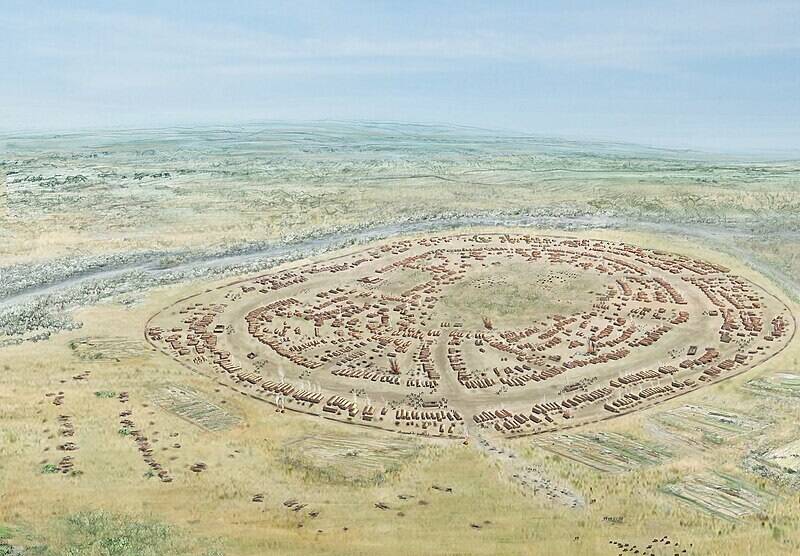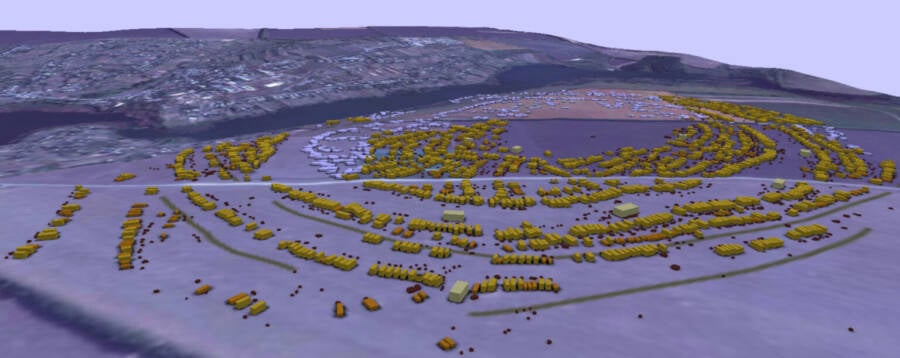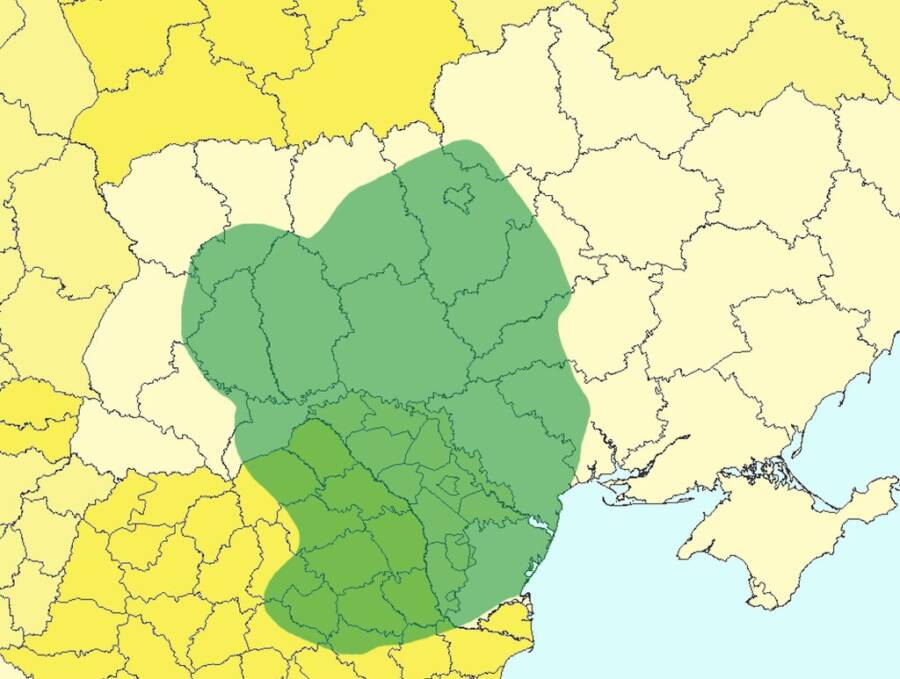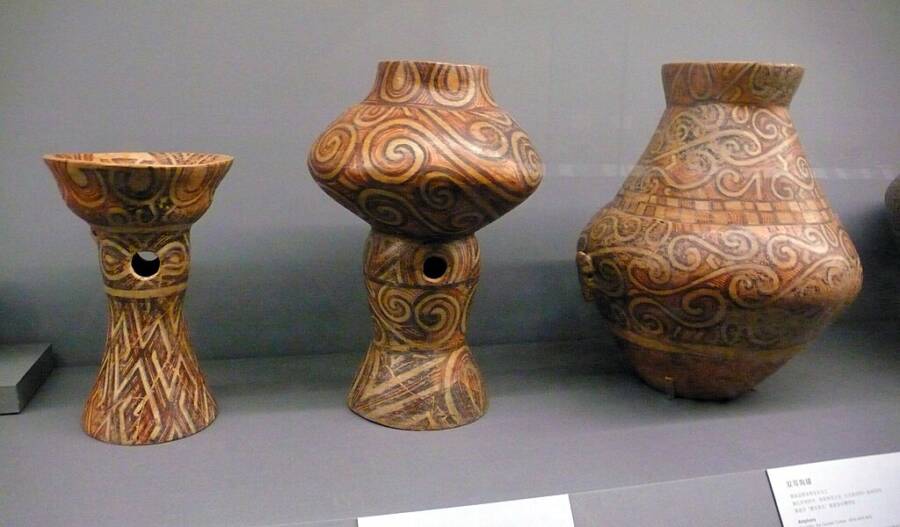Analysis of the Trypillia megasites in Ukraine suggests that they were built as early as 5500 B.C.E., challenging the notion that the oldest cities in world history were in Mesopotamia.

Wikimedia CommonsArtistic rendition of a Trypillia megasite, perhaps one of the oldest cities in the world.
For more than a century, scholars have largely agreed that the oldest cities in the world were built in Mesopotamia, mostly in modern-day Iraq, starting in the 5th millennium B.C.E. These early cities, including Uruk, Çatalhöyük, and Jericho, featured organized and large-scale residential planning, various elements of bureaucracy, and a social hierarchy that is reminiscent of a modern-day urban center.
However, excavations of ancient sites belonging to the Neolithic Cucuteni-Trypillia culture in present-day Ukraine have revealed evidence of what may actually be the oldest cities in the world, dating back to around 5500 B.C.E. Unlike traditional urban centers with long streets, these settlements were laid out in concentric circles, indicating a high level of planning and organization.
These discoveries have challenged long-held beliefs that the world’s oldest cities emerged in Mesopotamia, suggesting instead that urbanization may have independently developed in what’s now Ukraine. Researchers studying these Trypillia megasites aim to uncover more information about this mysterious culture’s rise and fall, offering a new perspective on some of the earliest chapters of human civilization.
Archaeologists Uncover The Trypillia Megasites In Ukraine, Perhaps The Oldest Cities In The World

Wikimedia CommonsA 3D model showing the general layout of the ancient Trypillia megasite of Maidanetske, which may be one of the oldest cities in the world.
In the 1960s, a Soviet military topographer named Konstantin Shishkin was examining aerial photos taken in Ukraine when he noticed strange shadows on a piece of land south of the capital city of Kiev. These shadows took the shape of concentric circles, soon discovered to be caused by archaeological ruins sitting just beneath the surface.
Analyzing the aerial photographs, Shishkin identified what looked to be more than 250 examples of these strange shadows spanning across a total of 741 acres.
In 1971, Ukrainian scientists studied the site using geomagnetics, a tool to track the presence of underground structures by identifying differences in Earth’s magnetic field. Eventually, scientists confirmed the presence of several massive ancient settlements with structures built in concentric circles.
Since then, researchers have flocked to the area to study the archaeological remains of what they believe to be the Cucuteni-Trypillia culture, a Neolithic group that occupied the area between 5500 B.C.E. and 2750 B.C.E. Researchers have since uncovered pottery and other artifacts from the prehistoric settlements believed to belong to this group.
In 2011, archeologist Johannes Müller from the University of Kiel in Germany began researching these Cucuteni-Trypillia settlements alongside his colleagues.
The team studied three sites: Maidanetske, Taljanki, and Nebelivka — all of which are located within a 50-mile radius. Using geomagnetics, the team re-mapped the settlements and used high-resolution imaging to locate the remains of various structures.
The team discovered that the structures were laid out in circular patterns. Instead of the alleys and long streets arranged in grid-like patterns that we associate with urban centers today, Cucuteni-Trypillia settlements were constructed in concentric rings. This suggests that all of the structures were carefully planned out before any construction began, strengthening the case that these settlements deserve to be called the oldest cities in history.
Inside The Cucuteni-Trypillia Culture That May Be Behind The Oldest City In The World

Wikimedia CommonsMap showing the rough extent of the Cucuteni-Trypillia culture, centering mostly on western Ukraine.
Although the Cucuteni-Trypillia culture dates back more than 7,000 years and largely remains shrouded in mystery, researchers have been able to uncover some specific details about how they lived, worked, and eventually faded into history.
In their well-planned cities, as many as 5,000-15,000 people lived in houses made of wood or clay. All of their domestic spaces were roughly the same size, measuring 16 feet wide and 46 feet long.
“The architecture is reminiscent of Lego, it was a modular system,” Müller told the Swiss publication Neue Zürcher Zeitung.
Some of these houses appear to have been purposefully burned down by the residents of the cities at various points. For what reason, however, researchers aren’t sure.
Interestingly, researchers are also unsure about the Cucuteni-Trypillia culture’s funerary practices. So far, researchers have not uncovered a single burial site from the time of these ancient cities.
“Individual graves are something with which the group of burying people represents their role to others. This reflection of social structures does not exist here,” Müller stated. However, “If there are no graves marked in an archaeologist-friendly way, that does not mean that a cult of the dead did not exist.”
What researchers do have are pieces of certain artifacts. The Cucuteni-Trypillia left behind thousands of pieces of pottery and other similar artifacts that provide a window into their daily lives.

Wikimedia CommonsThree pieces of pottery from the Cucuteni–Trypillia culture, which may have built the oldest cities in world history, circa 4300–4000 B.C.E.
Currently, Müller and his colleagues are hoping to unearth more information to shed light on some of the Cucuteni-Trypillia culture’s more mysterious aspects, including their death rituals, social hierarchies, environmental impact, and even their eventual collapse, about which almost nothing is known.
“That’s why we have to keep at it. We’re not finished with it yet,” Regina Uhl, a fellow researcher from the German Archaeological Institute, told Neue Zürcher Zeitung.
In the end, much remains to be uncovered about both the megasites that may be the oldest cities in the world as well as the civilization that built them.
After reading about what may be the oldest city in the world, dive into the stories of history’s oldest structures. Then, read about Göbekli Tepe, believed to be the oldest temple in history.





